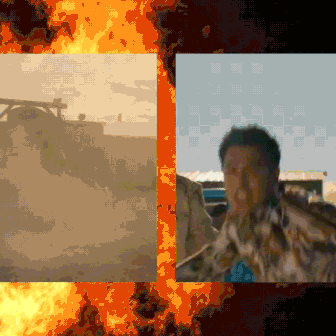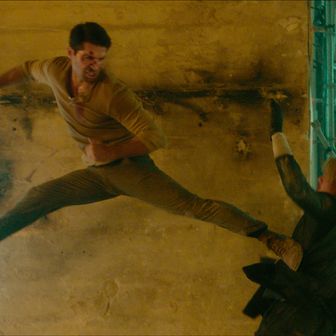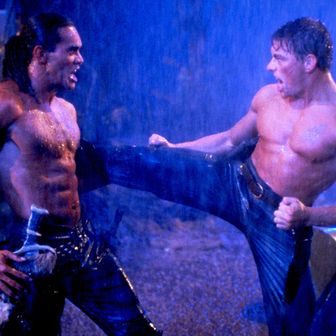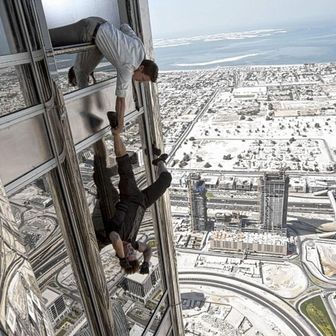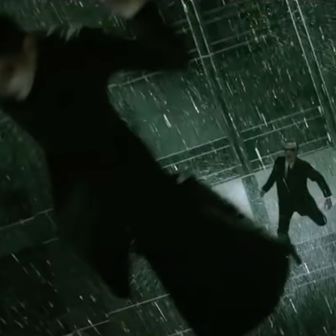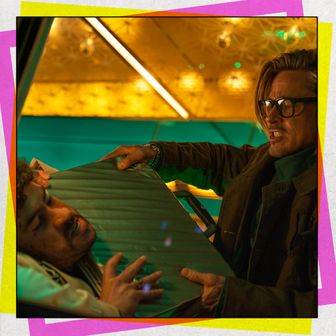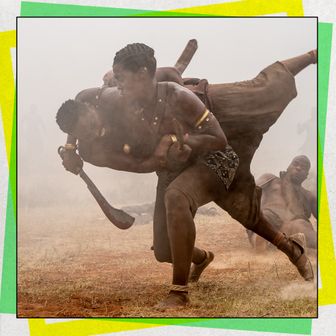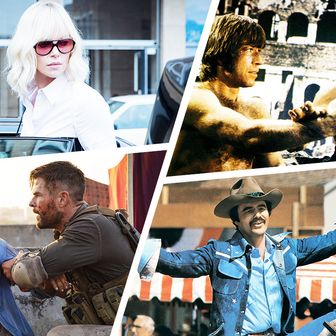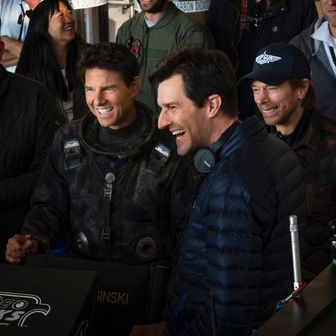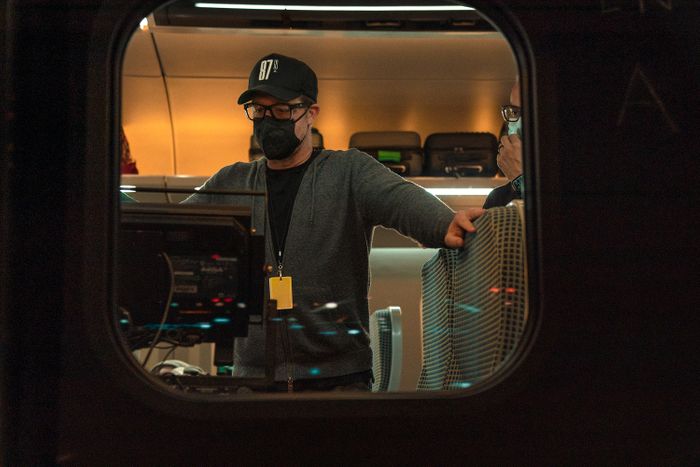
David Leitch is a recipient of Vulture’s first ever Stunt Award: Best Shootout. Read about the winners of the inaugural celebration of stunt professionals here.
You’d think it impossible to escape Brad Pitt’s shadow. Luckily, David Leitch is in the profession of making the unfeasible feasible. The director behind box-office hits such as Deadpool 2, Atomic Blonde, and Bullet Train began his career as a stunt performer and a body double for Pitt specifically. If you saw an action film in the 1990s or aughts, odds are Leitch was involved: Fight Club, Troy, and Mr. and Mrs. Smith are among the Pitt titles, and he was also in Blade, 300, a Bourne movie, an X-Men movie, and Captain America: Civil War. In 1997, he co-founded the action-design production company 87eleven alongside longtime creative partner Chad Stahelski, revolutionizing modern action in the process with, among other things, his team’s novel approach to wire work and rigging. That expertise is on full display in the final fight between Neo and Agent Smith in The Matrix Revolutions, a sequence Leitch admits was one of the most difficult of his career.
Leitch and Stahelski eventually took everything they learned under the Wachowskis and applied it to their own feature-length work, the first being Stahelski’s John Wick (Leitch was an uncredited co-director). Their individual contributions to action thereafter are impossible to overstate, a melding of tactical gunplay with outsize and fantastical Hong Kong–influenced choreography, reconfiguring what was possible to achieve onscreen with a medium-size budget. At a time when action was dominated by expensive flicks like the Fast or Bond films, Wick offered an exciting middle ground in which production design prioritized practical stunts that worked in perfect harmony with the high-paced cinematography — as a way of both keeping costs low and telegraphing how essential the action was to the film’s DNA. After Wick came Atomic Blonde, Leitch’s first solo project, for which Charlize Theron put in the work to make herself credible as a frightening assassin whose body-breaking stunts worked seamlessly to tell her character’s story and the film’s larger narrative.
Most recently, Leitch reteamed with the man he doubled as for years and directed Brad Pitt in Bullet Train. In one of the film’s standout moments, Pitt has a wild fight with rapper Bad Bunny, a feat of performance on the parts of the actors and stunt professionals who keep Pitt in the frame at almost all times. In another scene — one that gives Pitt a bit of a break — Aaron Taylor-Johnson and Brian Tyree Henry methodically spray gunfire upon an obstacle course of bodies. That scene was recognized by Vulture’s 2023 Stunt Awards, winning the Best Shootout honor. Leitch took the occasion to pore over his career up to now, recalling the stunts he loved doing, the choreography he’s most proud of, and the undeniable beauty of a good car roll.
Most difficult stunt of his career.
Stunts take on different shapes and sizes and levels of complexity depending on the discipline within which stunts are taking place. I, as a performer, did a lot of fight choreography with wire rigging and flying, bringing that Asian influence of Hong Kong wire work into western films. I think there was a sequence in the Matrix sequel The Matrix Revolutions where agent Smith and Neo were flying in the air. I, with the stunt-rigging team and the special-effects team, designed the flying rig where Chad Stahelski and myself could fight midair.
In itself, it wasn’t as dangerous as other stunts. But the logistics and the technology and the innovation was probably one of the most interesting and challenging stunts that we pulled off. It was tons of complicated rigging and wire work every day in a harness flying hundreds of feet in the air. How could we make this flying sequence look real at the birth of the modern comic-book movie? Which those movies were.
Secret to making action look “real” onscreen.
For me, realism isn’t actually that interesting. Generally, the movies I make are escapist fare. We’re building worlds that you can go to for a couple of hours. With John Wick and Atomic Blonde, the choreography and the stunts in there are grounded in some real physics — they’re not comic-book movies — but they’re also a stylized version of what fighting and car crashes can be. So I’ve always been careful about “Is it realistic?”
Could we pull off taking out 75 guys like John Wick does? Not even close. But does it work for our world? You have to find that tone of the action for every movie, making sure that the actions define character and build drama in the story so you actually care about it. There’s a lot of great movies that don’t have big characters and don’t have big drama; they have incredible action sequences, but they’re forgettable because you’re like, I didn’t enjoy the journey. Great choreographers and great action designers remember that we’re telling a bigger story than just the stunts or the car roll or the fight scene. If you can merge great drama or great character development in your actions with big ideas, that’s going to be the scene that’s iconic.
Action sequence he’s most proud of as a director.
I’m proud of the choreography that we designed in John Wick, which is now given this label “fun fu.” I think that was the first time that term was used. But my favorite sequence is in Atomic Blonde, and it’s the seven-minute, uncut oner with Charlize’s character, Lorraine Broughton, fighting in the stairwell and then fighting in the street and then driving in the car.
The camera never perceivably cuts. I think we did something really provocative with the action there — we stayed with the character. It took a lot of planning and logistics on the stuntwoman’s part, and I’m really proud of it. I’m proud of it mostly because it was dramatically compelling, far beyond the gimmick.
Go-to action move that always looks great onscreen.
A good cannon roll or car roll always looks great. As an action director and an action designer, I always push to have unique, beautiful stunts in movies — to show scale and stakes for characters. I think that’s why car rolls are so prolific in the Bond movies and the Mission: Impossible movies, because there’s an inherent danger with that speed that everyone can relate to. So I always try, whether they’re big or small, to have some vehicle action that people can look forward to in a film. A cannon roll, a pipe ramp — these are old school stunts, but there’s no replacing them in modern cinema. You know it’s real, and you feel it on the screen, and it’s visceral and big.
Secret to directing actors with no action experience.
One of my skills is having taught martial arts for so many years. You have beginners come in and they know nothing, so you break things down into smaller bits and they learn sections and that builds into bigger sections. Any good athletic coach — whether it’s gymnastics, martial arts — can break down the movement. Some actors can learn five, six scenes of choreography and they look like they’ve been doing martial arts their whole life the minute they walk in. Other people need to start with a single punch or balance and footwork, whether it’s just running and jumping over an object, and the progression builds and builds and builds. Good coordinators work well with their actors and build progressions to get them to do as much as they can safely and keep them in the movie as much as possible.
Actors who are surprisingly great at stunt work.
Charlize is incredible at choreography. Keanu is incredible at driving motorcycles. I did five movies with Brad Pitt as his stunt double, and he’s the type of guy where you don’t have to double him all that much because he can do so much. He’s such a great athlete. So as fun as his movies were, if I knew I had to do a stunt on one of them, it was probably going to be something that was really painful because otherwise Brad was going to do it.
Secret to doubling for Brad Pitt.
A good stunt double is a good mimic. For the actor, it has taken them great pains to create a character — the way they hold their body and the way they walk and the way they move. You as a stunt performer need to embrace that and mimic it. Sometimes it’s not always remembered by stunt performers, but a good stunt performer remembers it, rehearses that way, and tries to emulate what the actor is creating. As the stunt team, we are actually helping to build that character. You’re trying to create a seamless illusion for the audience.
And it might be that the actor needs to work on his movement within the action to be more like the double. A great stunt performer I worked with for many years, Jackson Spidell, is an incredible athlete and an incredible mimic. He worked with us on Deadpool 2. He and Ryan worked really close together to keep the illusion alive with whichever person was in the suit at that time. It’s not just “Put the stunt double in there for the frame until he hits the ground.” It’s really “How do you keep the illusion alive?”
Secret to choreographing a fight scene between the Rock and Jason Statham.
Great actors don’t worry about — there’s no tit for tat of “Who’s going to win? Who’s going to lose?” They care about the scene and the story and making sure that it’s dramatic for the audience. They’re friends, but they’re frenemies. The choreography with them always had to be a competition. We could choreograph the scene where they’re trying to break into the facility and Dwayne only has to fight one guy and Jason has to fight 12 guys. The drama of that allows you to show the disposition of these two characters that we’re building.
Worst injury as a stuntman.
One of my worst injuries that I had was early on in my career when I was auditioning for the Batman live show at Magic Mountain. I got the job, and I think we were rehearsing the first day. I hadn’t even done one show yet, and I was trying to do a really simple move. I jumped from a car to a gantry and I slipped, and when I put my hand down, I broke my wrist in seven places. I was out of the show. Never came back, and I had pins in my arm. Months of recovery.
Stunt he would never do.
I would never say “never.” I think that everything is innovating, and we use a lot of visual effects nowadays to augment stunts. I think, as long as the coordinators are going through the protocols and rehearsing, I’m really for the maintenance of the craft and the expansion of the craft. It’s really fun to see the old-school gags reinterpreted by younger generations, and it’s great to see stunts outside the movie business and within the extreme-sport community doing things that you didn’t think the human body could do. So then how do we apply that to the work that we do in film and make it safe? I’m impressed by the Mission: Impossible movies and Wade Eastwood’s work on that because I do think they spend years putting together those sequences and training Tom to do something that’s real and compelling.
How VFX makes stunt work better.
It gives us a lot more choice and a lot more freedom. I think the audience will always want to feel the thrill of a practical stunt, but depending on the tone or style of the movie, we can still do some really fun, incredible action that can be augmented with VFX. And if we can do something safely where we should do it safely — we can take out a lot of risks and still keep the illusion alive — it’s a good thing for stunts. I don’t think it’s an us versus them, like it used to be. I loved RRR, and I think that that’s a great example of the collaboration of the effects and stunts to do something really compelling that fits the tone and the storytelling of that movie. There’s a ton of massive practical stunts, but then there’s a lot of great effects complementing it. That movie was really a breath of fresh air.
Favorite stunt of all time.
I try to mine the work of the great Buster Keaton, Harold Lloyd, and Jackie Chan. There’s so many great things that those geniuses brought to us. I think of Buster Keaton and the house falling down around him. I did a little homage to that in Bullet Train, but it was visual effects.
I think that and Jackie in Police Story, where the guys fall out of the window of that bus. Or Jackie driving the car down through the shantytown. Jackie is basically a library of my favorite stunts.
More From This Series
- And the Winners of the 2024 Stunt Awards Are …
- The Second Annual Stunt Awards Are Here
- Academy Awards Reportedly in Preliminary Talks for a Stunt Category


